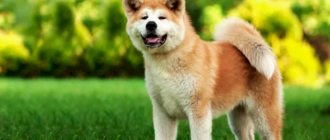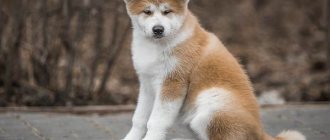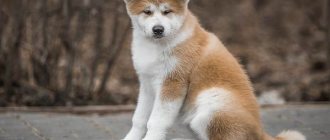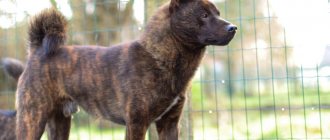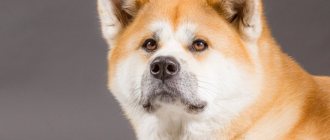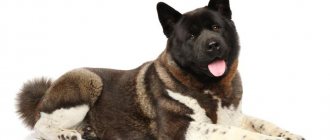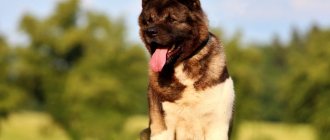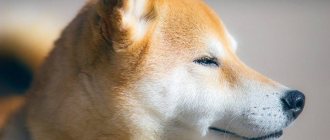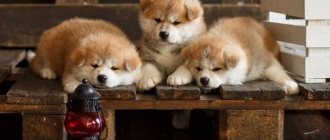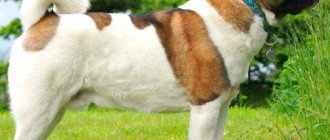Description of the American Akita breed
Popularity 12th among 263 dog breeds
Lifespan:
10-14 years
Height:
males: 65-70 cm, females: 60-65 cm
Country of origin:
Japan, USA
Average price:
20-30 thousand rubles
Weight:
32-59 kg
Latest articles Cat health
Rabies vaccination for cats: choice of vaccine, necessity, schedule 01/22/2022 4 0 0
Selection and adaptation
TOP 20 best cat breeds for families with children 01/22/2022 25 0 0
Advantages and disadvantages
- Pros:
- gets along well with children;
- does not bark over trifles;
- not intrusive and calmly tolerates loneliness;
- good guard qualities;
- loyal character.
- Minuses:
- may accidentally injure a preschooler due to its large size;
- does not get along well with other dogs;
- the difficulty of parenting;
- not suitable for keeping in a small apartment;
- needs frequent and long walks.
Key facts
Akita is an excellent guard and loyal friend. The price for a purebred puppy starts from 15 thousand rubles. The description of the American Akita breed emphasizes that the dog is somewhat larger than its purely Asian brother and progenitor - the Akita Inu.
The abbreviated name of the breed comes from the Japanese prefecture of Akita, but the official country of origin is the United States. Another name for the breed is “large Japanese dog,” emphasizing the large size of the animal:
- height at withers – 61-71 cm;
- The weight of the American Akita is 32-65 kg.
The maximum height and weight indicators are typical for males, the minimum - for females. In addition to the difference in size of the American Akita, males are distinguished by a more obstinate and pugnacious disposition. Females have a softer character, so they are well suited for owners with little experience. Individuals that are too aggressive or cowardly are rejected from breeding.
On average, a dog lives 12 years, and the maximum life expectancy of an American Akita with proper maintenance and care is 14 years.
When choosing a nickname, it is recommended to start from the characteristics of the American Akita breed. The English and Japanese versions sound equally good, especially if you put some meaning into them.
History of the origin of the American Akita
The country of origin of the breed is recognized as the USA, and the ancestor is the Japanese Akita Inu. The unusual journey of an aboriginal dog from the eastern islands to the New World was accompanied by many complex and interesting facts:
- Danger of degeneration. Before the arrival of the Americans, the Japanese risked losing their four-legged national treasure several times: the first time due to crossing with foreign dogs. The second time, most of the individuals died during the fighting of 1941-1945.
- Meeting the American military. Returning to their homeland, the Americans took with them several Japanese puppies.
- The emergence of a new breed. After the arrival of the unusual dogs, American breeders began breeding them without relying on Japanese standards. The grown-up puppies were dubbed large Japanese dogs, and their offspring - American Akita.
The Japanese did not accept the new breed for a long time and tried to win the right to a common pedigree, but their efforts were in vain. Over the years, the American Akita began to differ from its closest relative not only in appearance, but also in behavioral characteristics.
Americans achieved international recognition and an official breed standard only at the beginning of the 21st century.
Historical reference
The origins of the American Akita are closely related to the history of the Japanese Akita. Since 1603, Akita Matagi, medium-sized bear hunting dogs, have been used for dog fighting in the Akita region. Since 1868, Akita Matagi have been crossed with Tosa and Mastiff dogs. As a result, the size of the breed increased, and the characteristic features of the Spitz-type were lost.
In 1908, dog fighting was banned. However, the breed not only survived, but also flourished, developing into a large Japanese dog.
During World War II (1939-1945) the wool was used to make fur clothing for the military and the police confiscated all dogs except German Shepherds, which were kept for military service. Therefore, some fanciers tried to save the situation by mating their dogs with German shepherds.
When World War II ended, the Akita population declined sharply and existed in three different types:
- 1) Akita Matagi;
- 2) Akita for dog fighting;
- 3) herding Akita.
During the process of restoring the breed to its purity after the war, a male named Kongo-go from the Dewa bloodline enjoyed enormous popularity and success. Numerous Akitas from the Virgo bloodline, in whose appearance one can see the features of a mastiff and a German shepherd, were taken by the American military with them to the United States. Akitas of the Virgo bloodline, intelligent and easily adaptable to different conditions, fascinated US breeders, and the number of dogs and breeders of this line increased along with their popularity.
The American Akita Club was created in 1956, and in October 1972 the breed was recognized by the American Kennel Club (AKC): the breed was included in the stud book and admitted to exhibitions. Unfortunately, at that time the Japanese Kennel Club (JKC) and the AKC did not have an agreement on the mutual recognition of their certificates of origin, so importing new Japanese lines into the United States was not possible. Therefore, Akitas in the USA developed in a completely different way, not like in their country of origin - Japan.
This is how their own type of dog arose in the USA, which has not changed since 1955 and had characteristic breed characteristics. From this moment on, Akitas begin to be divided into American and Japanese. It was only in 1999 that the American Akita dog breed received recognition from the Fédération Cynologique Internationale (FCI).
Appearance of the American Akita
General impression
Due to its large size, the American Akita is becoming less and less like a hunting dog from Japan. Massiveness and heaviness impede mobility, making it difficult to develop sufficient speed.
From the photo of the American Akita it is clear that the dog was specially bred. They are characterized by large size, well-developed muscles and a bear-type muzzle, found in many Spitz-types.
Head
The Akita has a massive head in the shape of an obtuse triangle with a well-defined stop. Small folds are permissible only in an excited state; the rest of the time they are absent.
The breed description approved by the standard includes:
- small triangular ears, slightly rounded at the tips;
- deep-set small triangular eyes of a dark brown color and tight-fitting black eyelids;
- a wide black nose with well-opened nostrils;
- black lips set tightly against strong teeth with a scissor or level bite.
The chocolate-brown color of the lobe is acceptable only for individuals with a white coat color.
Neck
The head rests on a massive but short neck with pronounced muscles. There are small folds of skin under the larynx, and the convex nape has a smooth transition line to the base of the skull.
Torso
Pedigree dogs have a rectangular body with a wide and voluminous chest with convex ribs. The height at the withers is less than the length of the body, and the depth of the chest is equal to half its length.
There are no folds on the body. The skin fits tightly to the straight back, muscular lower back, moderately tucked belly and other parts of the body.
Forelegs
American Akitas have straight forelimbs with round (“cat-like”) paws and arched toes. According to the standard, the correct structure of the thoracic limbs should include:
- shoulders slightly sloping back with well-developed muscles;
- strong bones and large joints;
- slight inclination of the metacarpal bones (15° to the vertical);
- straight paw position;
- elastic fingers with thick skin and strong claws.
Marking and clubfoot are unacceptable.
Hind limbs
The hind limbs are not inferior to the forelimbs in muscles and bones and have an identical paw structure. If your pet has dewclaws, it is recommended to amputate them.
The midfoot is low and should not be turned inward. The knee joints have moderately pronounced angles and a parallel arrangement. The most pronounced muscles can be seen on the thighs.
Tail
The ring-shaped tail with thick fur forms an incomplete circle. Thanks to the high landing, part of the tail is located above the back. When unfolded, its tip reaches the hock joints, and in its natural position it is no higher than the surface of the back. The maximum thickness is noted at the base.
Movement
The dog moves with free but strong movements, making moderate pushes and lunges. Both pairs of limbs do not lag behind each other when walking and running and move in the same plane.
Wool
The body of the animal is covered with coarse, straight guard hair and soft, thick undercoat. The minimum hair length is typical for the ears, head and limbs, and the maximum for the withers, rump and tail.
Color
Unlike the appearance of Japanese relatives, the exterior of American dogs allows for any known color. If there is a pattern or spots, chaotic and smooth contours are eliminated. Differences in the color of the guard hair and the undercoat are acceptable. Thanks to this, the colors of the American Akita are very diverse.
Strict restrictions are imposed only on white individuals. The presence of a mask on such a dog is considered a defect.
Size
The pictures show that the American Akita has pronounced sexual dimorphism. The female is very easy to distinguish from the male by size:
- the weight of an adult female is from 32 to 45 kg, and the weight of a male is from 45 to 65 kg;
- The height at the withers of an adult female is from 61 to 66 cm, and the height of an American Akita male is from 66 to 71 cm.
Females are more graceful.
Distinctive features
According to breed standards, the American Akita has the following traits:
- The muzzle is shortened and shaped like a regular triangle with an obtuse angle.
- The head is quite large, visually reminiscent of a bear. Wide cheekbones and cheeks, a straight bridge of the nose, an expressive but smooth curve. The forehead is wide and flat with a shallow furrow and flows into the back of the head with a smooth curve.
- The ears are triangular in shape, slightly inclined towards the muzzle, and small in size. The cartilage is of medium density, moderately elastic, the tip of the ear when tilted is at eye level.
- The nose is completely black; for white dogs, brown or slightly blurred color is allowed.
- The mouth is U-shaped, the lips are black. Pincer bite, or scissor bite, teeth are strong and large. The tongue is pink without spots.
- The eyes are small, have the shape of a rounded triangle, the iris is dark brown in color, minor deviations are allowed. The eyeliner is black, the eyelids are lifted.
- The body is rectangular, slightly elongated in length. Regardless of gender, according to the standard, the width of the chest should be half the height at the withers. Wide chest, straight, proportional back. The pelvis is slightly narrower than the shoulders, the croup is powerful, the muscles are clearly visible. The neck and shoulders are dense and muscular. The skin is thick, does not sag or stretch.
- The paws are powerful and muscular, with large and harmonious joints, the wrists are slightly prominent. The front and hind legs are located on the same line, the muscles on the shoulders and hips are prominent. The fingers are developed, the hand is rounded. The paw pads are medium in size and have thick skin.
- The tail is powerful, slightly wider at the base than at the end, curled into a ring or semi-ring. When unfolded, the length reaches the hock joint. When rolled, the tip touches the spine. The base of the tail is raised above the spine.
- coat has a fluffy undercoat and coarse outer hair. The undercoat can be lighter or darker than the main color. With white pigmentation there should be no masks or spots.
The American branch allows any colors: white, brindle, fawn, red and spotted. The American Akita is allowed to have a dark mask, which the Akita Inu does not have.
Character of the American Akita
In order to understand how the American Akita differs from the Japanese Akita, you first need to look at their similar features:
- Devotion. The dog does not choose a favorite and gets along well with children. The “American” will never give his owner offense and will steadfastly endure any childish pranks. An Akita can injure very young children by accident, not calculating its size during play. For the safety of the child, do not leave him and his four-legged “nanny” at home unattended.
- Love of freedom and independence. Even a small puppy will not be overly intrusive. If we are talking about who this breed is suitable for, then first of all we should mention workaholics. Immediately after purchase, a puppy missing its mother may become restless. Adult dogs are more psychologically stable and will easily find something to do.
- High intelligence. Akitas have a very good memory. If you have such a smart pet, do not forget about honesty in relationships. Any deception will negatively affect trust.
Unlike Japanese dogs, the character of the American Akita is more peaceful. They get along more easily with other pets and are less pugnacious. Despite this, it is better to keep your pet (especially a male dog) on a short leash when outdoors to avoid a possible fight.
When kept in an apartment, an Akita will not disturb neighbors with its barking. Representatives of the breed have a developed guard instinct, so at home they zealously defend their territory. A sudden burst of barking is a signal indicating danger.
Living with an “American” in a big city will not cause problems for others, but it can negatively affect the dog’s health. Freedom of movement is important for the Akita, so it is more comfortable for her to walk in a suburban area. Thanks to its thick undercoat, the dog can easily live outside in winter, but being kept on a chain will be perceived as an insult.
Features of character and behavior
The American Akita has a pronounced temperament and a greater love of freedom than the Japanese Akita. It can show aggression, but it does this rarely and only to protect itself or its owner. Dogs of this breed have a freedom-loving character and strive for a dominant position.
Advantages
- The main goal of the Akita is to guard the territory and protect the owner , which is facilitated by the nature of the animal.
- The American Akita is capable of making independent decisions and is highly intelligent.
- Dogs, as a rule, are patient and rarely lose their calm , and do not succumb to panic or mood swings.
- The description of the breed indicates the friendliness and proud nature of the animals .
- Akita rarely barks for no reason , but can use its voice to indicate its territory.
- With thorough upbringing, the animal will become an excellent companion , which will be able to accompany the owner on the hunt, protect the house, and perform service.
- high intelligence makes it an excellent guide dog for people with visual impairments.
Flaws
- Animals strive to dominate other pets, and in adolescence they may try to dominate their owner.
- The breed is not suitable for inexperienced breeders and people who do not have leadership qualities. The dog will ignore an owner who is weak-willed or not decisive enough.
In order for an Akita to grow up to be an obedient and well-mannered member of the family, it will require long-term and fairly rigorous training, which only an experienced dog breeder can do.
- It is not recommended for the dog to be near small children who can cause pain - in this case, the Akita, having hunting instincts, can attack and seriously injure.
- The dog treats older children calmly and protectively.
- The puppy should be in the company of other dogs from the age of 4 months - this will help the dog to get along with animals in the future.
Education and training
Despite its devotion, the Akita is characterized by dominance. Before purchasing a new family member, learn how to raise one.
Education and training of the American Akita should include:
- Systematicity. Inexperienced owners doubt whether it is possible to train a small puppy. If you want to raise an obedient dog, regularly conduct basic training from the day it arrives in the house. Before vaccinations, be sure to train your puppy to toilet in a diaper and never allow him to chew on old shoes if you don’t want to say goodbye to new ones.
- The authority of the owner. Training an Akita threatens complete failure for a weak-willed owner or a small child. Never give in when communicating with your pet and follow the rules regarding prohibitions. Otherwise, you will have to rack your brains to figure out how to wean your dog from sleeping on the bed.
- Interest. The pet quickly loses interest in the monotonous process, refusing to perform boring exercises. Conduct training in a game format and be sure to reward the correct actions.
Double-layer wool allows you to train your Akita outdoors in both cold winter and hot summer. During street training, remember about safety. From mid-spring to mid-autumn, be sure to treat your dog for ticks.
Avoid corporal punishment and yelling. Even a well-mannered dog can become willful. This is inherent in his character and is ineradicable, but there are ways of gentle influence:
- Pressed to the floor. Press down on the dog's back. Act confidently, but carefully so as not to hurt your pet. Hold the position until the resistance is relieved.
- Grabbing by the withers and then pressing to the floor. If you don’t know how to train a stubborn puppy to obey, then this method will come in handy. This is what mothers use when trying to reason with their naughty four-legged babies. Please note that it is prohibited to pick up adult dogs by the withers. Heavy weight can injure their vertebrae.
A trained dog is a guarantee of the safety of the owner and the people around him. If you have problems with education, be sure to seek help from a dog trainer and sign up for classes.
Looking for an American Akita? Find your pet from 1 offer As a gift
Health and Diseases of the American Akita
Possible diseases
The breed is distinguished by strong immunity and a high (for large dogs) life expectancy. For the health of your four-legged pet, it is important to follow the vaccination schedule, do not forget about anti-parasitic treatment and regularly clean his ears, nose, eyes and teeth.
Most often, diseases are associated with improper care and maintenance. Lack of physical activity leads to obesity, and poor nutrition leads to allergies, accompanied by hair loss on the tail, face, paws, ears and other parts of the body, depending on the degree of the reaction.
Diseases inherent to the breed at the genetic level are less susceptible to treatment:
- retinal atrophy and other eye pathologies;
- intestinal obstruction, which prevents you from going to the toilet regularly;
- hip dysplasia;
- Itsenko-Cushing syndrome, characterized by damage to the endocrine system.
To avoid these troubles, when purchasing a puppy, inquire about the health of its parents, ask for the necessary certificates and even x-rays of the baby and his mother.
Reproductive health
The first heat in American pets occurs at 12-14 months, but it is better to start planning offspring no earlier than 2 years. If procreation is not planned, then be sure to sterilize the animal. Early sterilization reduces the risk of breast tumors.
The gestation period is calculated from the day of successful mating and is 56-72 days. When puppies are born, not all dogs are ready to rupture the amniotic sac on their own. For a safe birth, seek help from your veterinarian in advance and do not try to shoulder everything without sufficient experience.
Features of feeding and diet
Feeding your pet can be dry or natural. When feeding dry food, choose food of at least super-premium class and follow the standards indicated on the packaging.
If an animal is diagnosed with a disease, then only a doctor will determine which food will be safe and beneficial for the sick person’s body.
When choosing natural food, the dog is fed according to the following proportion:
- meat and offal – 50% of the total diet;
- cereals – 25%;
- vegetables – 25%.
If you doubt whether you can give your animal some controversial product, consult a veterinary clinic. Some foods are not only unhealthy, but also dangerous, regardless of the dog’s age.
When purchasing a puppy through a nursery, the staff will definitely advise you on what to feed the baby until it grows up. Do not try to buy a one-month or two-month-old puppy. At this age, they feed on breast milk, and it is not recommended to separate them from their mother.
The first complementary food is given to puppies older than 2 months. In order to understand how many times to feed your pet, consider its age:
- up to 3 months – 5-6 times a day;
- 3-6 months – 4 times a day;
- 5-12 months – 3 times a day;
- over 1 year – 2 times a day.
Before purchasing, be sure to check with the breeder what kind of food the puppy was fed. A sudden switch to a new brand will cause digestive problems.
Mating
- In female Akitas, their first heat occurs between 8 months and one year of age. On average, it lasts two to three weeks and is repeated every six months.
- To give birth to healthy puppies, you should prepare for breeding in advance . The owner of the bitch needs to keep a diary in which the dates of estrus, the condition and behavior of the dog will be recorded.
- Before the intended mating, a month and a half before, you should be examined for the presence of infectious diseases, dewormed and vaccinated with a polyvalent vaccine.
- Animals must be introduced before the onset of heat and the reaction of the bitch to the male must be observed.
- Before mating, your pet should not be overfed , as this will have an adverse effect on pregnancy. In this case, the dog should not be too thin, otherwise a miscarriage may occur.
Care and maintenance
When keeping in an apartment, walk the dog at least 2 times a day for 1-2 hours. Walks should be active and exciting, so try combining them with training.
Regular care for your Akita should include the following procedures:
- Combing. Unlike long-haired breeds, the American's coat does not mat. The pet does not need a haircut, but it sheds a lot. During shedding, the dog will have to be brushed daily, on other days - a couple of times a week.
- The washing up. Akita wool does not have dirt-repellent properties, so it needs to be washed every month.
- Cleaning ears, eyes and teeth. Check your ears and eyes daily to prevent serious illnesses from developing. When caring for your mouth, use toothpastes designed specifically for dogs. Chewing toys for animals are suitable for preventing tartar.
- Paw treatment. After a walk, lubricate your pet's paws with vegetable oil to avoid cracks.
- Nail trimming. If you have little experience, visit a grooming salon to see how to care for your dog's nails. Experts will show you how to handle a nail clipper and avoid chips and burrs. The procedure is carried out once a month.
In general, keeping and caring for an American Akita will not be difficult if you have the proper skill and a dog accustomed to daily procedures.
Breed characteristics
The American Akita has a strong and independent character with a stable psyche. Maintenance will not be possible for a beginner or a busy person: this breed requires serious education and care.
Does not accept rude attitude - it is necessary to show calmness and leadership qualities. In addition, she needs the owner's attention - she is not left for a long time without communication.
These are quiet and peace-loving dogs, they practically do not speak.
They are indifferent to strangers and love those with whom they see often. They are friendly to guests, but if there are no owners at home, then not a single person will enter the protected area.
Learning commands and training begins from puppyhood. If there is no experience, then a specialist is hired.
Tips for choosing a puppy
Opt for trusted kennels with good reviews or experienced breeders registered with the kennel club. Buying secondhand is fraught with deception and purchasing a mixed breed for the price of a purebred puppy.
If you are in doubt about how to choose a healthy and purebred puppy, follow simple rules:
- Choose the most active one. Lethargy is an alarming symptom of many diseases.
- Inspect the exterior carefully. You can first seek advice from the owner of an American Akita or watch a video on the Internet. Make sure that the coat, eyes and ears are in good condition and are in good condition. A puppy that is too potbellied may be infected with helminths.
- Meet the parents. Meeting adult animals will help you learn the character of your future pet. Dogs that are aggressive or cowardly are more likely to pass on their genes to their offspring.
The cost of American Akita puppies often depends on the class, which determines whether the exterior meets approved standards. Before purchasing, think about the purpose of purchasing your future pet. In some cases, this can save money. Regardless of the chosen class, the seller must provide:
- a puppy card containing basic information about the animal;
- a pedigree confirming the breed and demonstrating all possible ancestors;
- veterinary passport used to show all vaccines received.
In addition to basic documents, a purchase and sale agreement must be drawn up for the puppy, guaranteeing the legality of the transaction.
How to choose a puppy
You should buy an American Akita puppy from trusted breeders who have been on the market for several years. It would be useful to find all possible information about the seller on the Internet and read reviews. An experienced breeder who values his reputation will definitely tell you which puppy is best for you. Some need a good hunter, others need a potential winner of all possible exhibitions, and others just need a good and faithful friend for themselves and their children, and to protect the house.
American Akita puppy with mom
Be sure to look at the parents of the future pet. This is very important because the offspring inherits their appearance and behavior. If it turns out that the mother or father is cowardly or, conversely, aggressive, then the puppy you choose may very likely turn out to be the same.
Be sure to pay attention to the appearance of the American Akita puppy. He should have shiny fur that is soft to the touch. While petting such a puppy, an association with a plush toy involuntarily arises. If he is too thin, has a swollen tummy, red and watery eyes, or twisted elbows and knees, then it’s better not to take risks and don’t take it. You should not take a puppy that is too young in age, since professionals do not assign show classes to dogs under 9 months.
Your future pet should be active. Lethargy in behavior is a sign of depression, which in turn may indicate a particular disease. If possible, to rule out hidden illnesses that may manifest themselves in the future, pay attention to the puppy's feces. Its consistency and color may confuse you. In this case, you should refrain from purchasing.
